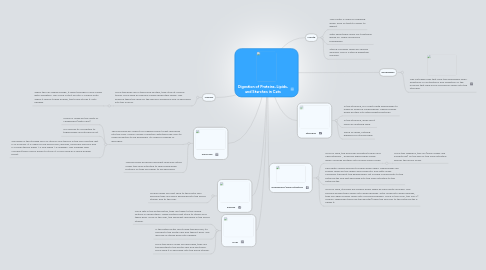
1. Kidney
1.1. Smaller lipids are sent here to the portal vein because they are easily absorbed into the blood stream and to the liver.
2. Liver
2.1. Once fats in the enterocytes, they are taken to the lymph system in lipoproteins. These proteins get stuck to others and taken here. Once in the liver, the lipids get absorbed in the blood stream.
2.2. If the enterocytes don't need the glucose, its passed to the portal vein and takes it here. The glucose is stored here until needed.
2.3. Once the amino acids are absorbed, they are transported to the portal vein and sent here. Once here it is absorbed into the blood stream.
3. Tissues
3.1. Once the lipids are in the blood system, they stop at muscle tissue. Once here an enzyme called lipoprotein lipase. This enzyme takes the lipid off the glycerol backbone and is absorbed into the muscle.
3.1.1. When the cell needs energy, it goes through a cycle called Beta-oxidation. This cycle cuts it up into 2-carbon units. When it doesn't need energy, the tissue stores it until needed.
4. Pancreas
4.1. The pancreas will used it for making insulin to get absorbed into the cells. Insulin causes a reaction with the body cells to make receptors to be absorbed. It's used for energy or glycogen.
4.1.1. Insulin is made by the Islets of Langerhans( Beta cells)
4.1.2. If in excess its converted to triglycerides and stored as fat.
4.1.3. Glycogen is the storage form of starch. One third is in the liver and the rest is in muscles. It is used for red blood cells, gonads, and brain neurons and is connected by alpha 1-4 and alpha 1-6 linkages. This linkages help compact them and is easier to store. It is also used as a quick energy boost.
4.2. The pancreas produces different enzymes listed under the small intestine to help break down proteins so they are easier to be absorbed.
5. Mouth
5.1. The mouth is used for breaking down food so that it's easier to digest.
5.2. With lipids there really isn't anything going on. There is phyiscal breakdown.
5.3. Starch is broken down by salivary amylase. This is a starch digesting enzyme.
6. Esophagus
6.1. Has cartilage rings that hold the esophagus open. Peristalsis is contractions and relaxation of the muscles that help move food bolus down into the stomach.
7. stomach
7.1. In the stomach, HCl reacts with pepsinogen to make an enzyme called pepsin. Pepsin breaks down protein into intermediate particles.
7.2. In the stomach, lipids don't really do anything here.
7.3. Same as lipids, nothing happens for starchs here.
8. Duodenum/small intestine
8.1. Once in here, the pancreas secretes trypsin and chymotrypsin , enzymes which helps break down complex proteins into simple amino acids.
8.1.1. Once this happens, the villi (small finger-like projections) on the wall of the small intestine absorb the amino acids.
